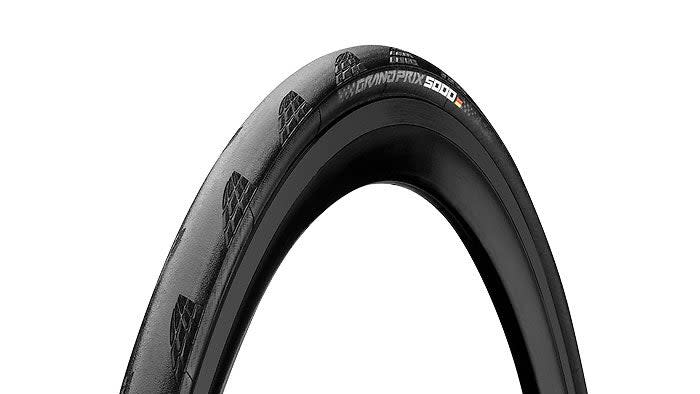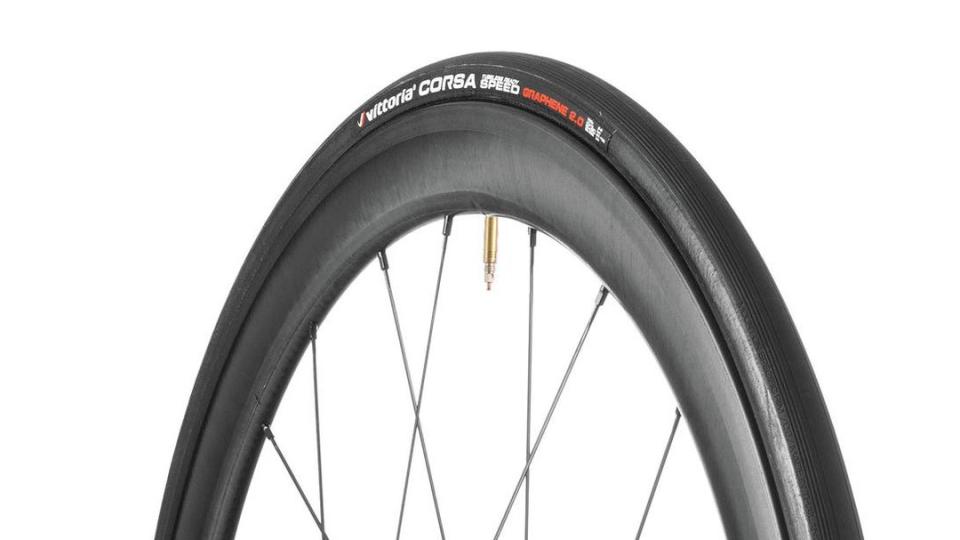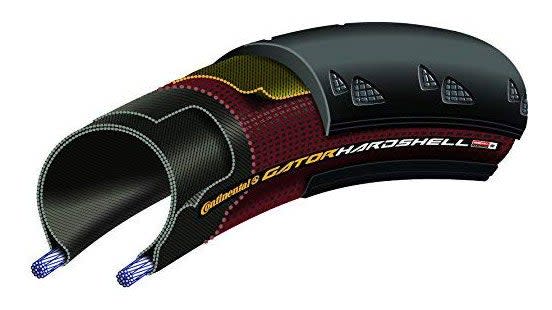Ask A Gear Guru: What Are the Best Tires for Triathletes?
This article originally appeared on Triathlete
Just like everything, cycling gear changes all the time. Not only do new materials get developed and new technology gets cooked up in labs, but sometimes the baseline logic that we all thought was The Word gets completely flipped on its head. The best tires for triathletes 15 years ago look almost nothing like the best tires for triathletes today.
Just look at rim width: Triathletes used to run skinny little 19mm rims with skinny little 19mm tires. With the proliferation of disc brakes that help reduce the need for rim width limits and new research looking at the need for a wider rim to match a wider tire that rolls better and is more comfortable, we’re seeing road wheels with massive 31mm outer widths.
Tires are the same way. The idea used to be that super narrow tires (think 19mm or 21mm at max) were the best option for race day. The logic went that a thinner width would present slightly less of an aero profile, but more importantly a thinner tire would roll faster because it would contact the ground less. Triathletes also thought the best tire was something narrow, nearly busting off the rim at 130+psi--”If it's a super rough ride," we thought. "Then it must be super fast." We now know none of that to be an absolute truth.
Clinchers Or Tubulars For Triathletes?
Not only did we love narrow, super high pressure tires, but the standard was: Clinchers for training, tubular for racing. Tubular tires--the ones with the tube sewn into the tire itself (some people call them "sew ups") and physically glued onto a special tubular rim--were generally lighter and some felt that they had better cornering and acceleration. However tubular tires were a huge pain to stretch and glue properly, they were expensive, they required a special rim, and God forbid you had a flat out on the road. Long story short, we should all be thankful the whole tubular thing in tri is pretty much over.
As tubular tires began to fall out of vogue, clinchers--the tire that most people are familiar with that uses a removable tube inside a tire--began to take over. It turned out that rolling resistance was actually better in most clinchers, and of course triathletes need to be able to change flats out on the road. Using a clincher for race day also means you can save up your extra cash for entry fees instead of spending it on race-day-only tubular wheels that sit in the garage for most of the year. It also helped that carbon clinchers were being made stronger, braking better (this is a big one), and could be used basically all of the time.
What Size Tires Should I Get? What Pressure Should I Run?
The next big change in tires came in terms of size and pressure. Again, we won't go too in-depth on why we now know wider and lower pressure (down to a limit) is better (check out this story for more), but gone are the days of a 19mm tire ballooned up to 180psi. Now we know that a wider tire in many circumstances has a faster rolling resistance--we see most pros in Kona running 25c tires, with a few even experimenting on 28c. Road cyclists are falling mostly into 28c--and we know that a pressure down near 80-90psi depending on weight/tire/application is actually faster. Wider tires also let us run a lower pressure more safely because there's more distance for the tire to compress before hitting the rim and causing the dreaded pinch flat that is often a symptom of a tire with too little pressure.
For triathletes, this wider/lower "trend" is an absolute jackpot: A wider tire with lower pressure will make a substantial difference in how much road vibration we feel during the bike leg. This can be like the difference between harsh aluminum bars/wheels/frames and something made of carbon that helps give a little bit. You'll be gripping the bars lighter in a more relaxed aero position, and your back and butt will take far less abuse without having to spend on fancy carbon. Less road fatigue means faster run splits, and that's all triathletes really want, right? Right?
What Are Tubeless Tires?
The next step on the evolution of the modern triathlete tire over the last decade now seems to be the tubeless tire. No, this isn't just another name for a tubular tire (though yes, they sound similar). A tubular tire had a tube sewn in--though you never really saw it unless you were like a tire surgeon or something--a tubeless tire has no tube at all.
Used mostly in mountain bikes, a tubeless tire uses a special tubeless-ready rim that allows a tube to hook directly onto the rim bead--kind of sort of like most modern-day car and on-road motorcycle tires. The big difference in a bike tubeless tire is that we don't use a machine to set the bead, and we need to use a sealant to help keep the rim set (and to prevent punctures). The process for setting up a tubeless tire is slightly cumbersome (and can be messy)--made easier if you have an air compressor--but the result is a fairly light system overall with the best possible rolling resistance you can achieve. The reasons for this are pretty complicated and involve the friction between a tube and a tire that we won't get into.
The other upside to tubeless tires--and the reason the off-road set uses them--is you can run an even lower pressure, a pressure that might not actually be that fast on the road but could be good if conditions are wet and the course is super technical. The sealant also helps prevent/slow down leaks due to small cuts and punctures, but trust us when we say you don't want to get a full flat when out on the road with a tubeless setup. You can still use a tube to save you, but you'll need to remove the valve stem (which is easy) and reseat the tire itself, now with a tube in it (which is not so easy).
The next evolution in tubeless tires is now hookless rims that create a smooth transition from tire to rim when seated. Rooted in mountain biking, this could have big implications for triathletes once they become more popular, as the smooth transition from tire to rim is aerodynamically better than the old standard clincher rim.
Should A Triathlete Use Tubeless Tires?
Tubeless tires aren't necessarily going to become the go-to tire for triathletes because they are difficult to set up, and despite their excellent rolling resistance, their big strength also lays in lower pressure for super tight corners (and super good technical cornering skills). Also, the difficulty in changing a flat makes the prospect a little scary for race-day use. The biggest and best time triathletes should be using a tubeless tire? If you're running a disc wheel. And the proliferation of tubeless-ready wheels and disc brakes mean that triathletes should be flocking to get their hands on a disc wheel again.
Without getting too far into the disc wheel discussion, tubeless tires allow riders to run a very low pressure, nearly eliminating the harsh ride that discs are notorious for. No longer will you come off the bike feeling beat up by your disc. Disc brakes also eliminate the fact that carbon-rimmed discs are easily some of the worst braking wheels in the planet, but let's stick to tires and check out some of our favorites below:
The Best Tire For Triathletes Who Want Something to Train and Race On
Continental GP5000
$50 each, 23c-32c, 220g (25c), 330 TPI, Backcountry.com

The long-awaited update to the super popular GP4000 also comes in tubeless ready version (a first for Continental) and a wide range of sizes. This tire has excellent rolling resistance, is moderately grippy, and boasts one of the best anti-puncture compounds in the game. The GP5000's weight falls in the mid-range, but for triathletes looking to roll quickly without incident, this tire is tough to beat. At the pro bike rack in Kona, this is one of the most popular setups.
The Best Tire For Triathletes Who Want to Roll
Vittoria Corsa Speed G+ 2.0 TLR
$79 each, 23c-25c, 240g (25c), 320 TPI, amazon.com

This tubeless ready tire from Vittoria puts the brand back on the map for high-performance with a tubeless ready tire (also compatible with a tube, but it's a tough fit) that basically crushes other brands in terms of rolling resistance. On the independent website, Bicyclerollingresistance.com, the Corsa Speed G+ 2.0 was half a watt faster than the next brand--which is actually quite a lot. This is also a good tire choice because the puncture resistance is actually quite good when compared to race-day only rubber.
The Best Tire For Triathletes Who Want Puncture Protection
Continental Gatorskin Hardshell
$40 each, 23c-32c, 270g (25c), 180 TPI, Competitivecyclist.com

Though this makes two Conti tires in the list, it's tough to beat the puncture protection of their Gatorskin line, and the hardshell option offers another tough layer in its three-layer rubber. This is the tire to use in the winter, when there's more debris on the road, and it's sticking to your tires more often. The Gatorskin's weight, TPI, and rolling resistance make it a less-than-ideal choice for race day (unless flat paranoia is the name of your game), but it's an excellent training option.
The Best Tire For Triathletes Who Want to Climb
Pirelli P Zero Velo TT
$52 each, 23c-25c, 180g (25c), 127 TPI, Amazon.com

If you've got a crazy hilly tri coming up (without too much technical descending) then the P Zero is bar-none the lightest practical choice. Weighing way less than most other options that aren't sketchy-thin tires, the acceleration and feel while climbing is definitely noticeable. Just like anything, there's a tradeoff in terms of grip (127 TPI is quite low) and it's not available in super wide or tubeless versions, but the P Zero Velo TT is still worth checking out. Also, bear in mind that while rolling resistance is still reasonably low, puncture protection is not high enough to necessarily warrant daily use if you live in an area that's prone to punctures.
Best Tire For Triathletes Using a Trainer
Kurt Kinetic Trainer Tire
$30 each, 25c, Competitivecyclist.com

Obviously, you can use an old tire on your wheel-on indoor bike trainer, but if you prefer to have a dedicated wheel/tire for the long winter months, it's a good idea to invest in a tire like the version from Kurt. Not only will you avoid shredding your good rubber, but this setup will create less noise and not leave tiny bits of black all over your pain cave. Don't worry about weight, TPI, or anything else here, just buy this relatively inexpensive rear tire that works only for the trainer and bang out those long indoor miles.
For exclusive access to all of our fitness, gear, adventure, and travel stories, plus discounts on trips, events, and gear, sign up for Outside+ today.

